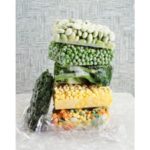What to freeze in the freezer for the winter
During the season of vegetables, fruits, and berries, the diet is replete with variety and vitamins. Experienced housewives know that it is easy to extend this period for the whole year - by freezing. Almost all refrigerators are equipped with a freezer, but not all of them are used in the most practical way. What to freeze in the freezer for the winter? These can be fruits, vegetables and much more.
The content of the article
What vegetables can be frozen for the winter?
You can prepare almost everything for the winter (there are few exceptions, but they exist). Many foods are frozen individually, but it's convenient to put them in bags and mixes, especially if you cook certain dishes often.
Important: for freezing, you need to choose fruits of good quality (overripe ones are best left for other purposes), areas with damage or rot are removed in advance.
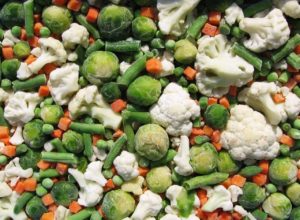 The best vegetables to freeze are eggplant, pumpkin, peppers, cauliflower and broccoli.. Some housewives also store tomatoes and cucumbers in winter (the latter are only suitable in grated form for okroshka). Popular mixtures include preparations for green and red borscht, paprikash, risotto, stew, lecho, and paella. There is no need to defrost the vegetables first - you can start cooking right away.
The best vegetables to freeze are eggplant, pumpkin, peppers, cauliflower and broccoli.. Some housewives also store tomatoes and cucumbers in winter (the latter are only suitable in grated form for okroshka). Popular mixtures include preparations for green and red borscht, paprikash, risotto, stew, lecho, and paella. There is no need to defrost the vegetables first - you can start cooking right away.
It is preferable to prepare all vegetables immediately in the form in which they will be used for cooking. It’s convenient to just grate frozen fruits, but you can’t cut them with a regular knife, so you should chop the vegetables before freezing.
Help: to speed up the cooking process, you can store grated carrots and onions in the freezer, chopping off the necessary parts if necessary.
How to properly freeze fruits and berries for the winter?
Freezing fruit is much preferable to canning or making jam, as this method allows you to preserve more vitamins and nutrients. They can be prepared either whole or chopped.
An interesting option is to prepare fruits and berries in the form of puree, sorbet or ice cream. All this is subsequently consumed directly or added to smoothies, cocktails, compotes and even baked goods.
- Among the berries, strawberries, currants, raspberries, sea buckthorn, gooseberries, lingonberries, wild strawberries and blueberries are often frozen in containers, simply sprinkling the layers with sugar. In this case, it is not used for preservation, but in order to best preserve the taste of the berries.
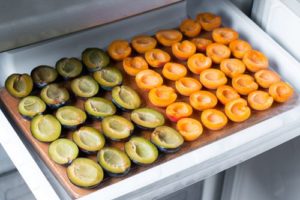
- Berries with seeds should be frozen without removing them, however, this is unacceptable with fruits: plums and apricots should be cut into halves or slices, getting rid of unnecessary parts.
- Among other fruits, peaches, pears, sour apples, and citrus fruits tolerate being in the freezer well. The latter, low temperatures also allow you to get rid of bitterness.
- Watermelon should not be frozen in pieces: it is better to immediately grind it into puree. With strong cooling, its consistency changes, but the taste does not, so the finished puree can then be used in smoothies and sorbets.
- Tropical fruits are also prepared in the freezer.Only avocado should be stored separately, as it is rarely used in sweet dishes. The skin is removed, the pit is removed, and the pulp is cut into cubes. The same approach applies to mango and papaya. Pineapple should be stored without peeling, cut into rings or cubes.
Important: all fruits and berries must be washed and dried before freezing, and the stems, leaves and seeds must be removed if possible.
Preparing and storing mushrooms in the freezer
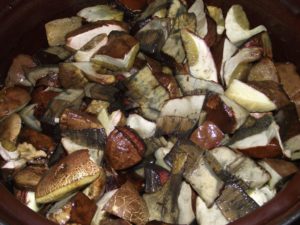 Freezing mushrooms is the fastest way to process them. At the same time, they retain their taste and texture well. But unfortunately, most mushrooms should be boiled before going into the freezer. This point can only be avoided with champignons, oyster mushrooms and porcini mushrooms.
Freezing mushrooms is the fastest way to process them. At the same time, they retain their taste and texture well. But unfortunately, most mushrooms should be boiled before going into the freezer. This point can only be avoided with champignons, oyster mushrooms and porcini mushrooms.
Depending on their size, mushrooms can be stored either whole or chopped. Because of their voluminous cap, it is better to chop the champignons into slices.
Important: after defrosting, mushrooms should be used immediately. They should not be subjected to secondary freezing.
Features of freezing greens
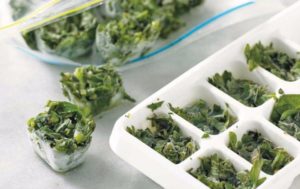 Freezing greens is as easy as shelling pears – many people begin to master this task with it. You can harvest anything: dill, parsley, celery, cilantro, rosemary, salads, beet tops and even parsley stems, which can then be used when cooking broths. The only thing you shouldn't put in the freezer is green onions, as low temperatures significantly reduce their sharpness.
Freezing greens is as easy as shelling pears – many people begin to master this task with it. You can harvest anything: dill, parsley, celery, cilantro, rosemary, salads, beet tops and even parsley stems, which can then be used when cooking broths. The only thing you shouldn't put in the freezer is green onions, as low temperatures significantly reduce their sharpness.
The greens must be washed and dried thoroughly so as not to end up freezing a lump of water. You can harvest it either whole, carefully pulling the bunches together, or in finely chopped form.
Help: you can quickly cut a large amount of greens with ordinary scissors.
To make cooking easier, you can freeze mixtures of greens directly or in some base, such as butter or olive oil. Such cubes are immediately thrown into the finished dish: under the influence of temperature they will immediately melt.
Freezing semi-finished products
In addition to the usual cutlets and dumplings, which almost everyone freezes, stuffed peppers and pancakes, pies, cabbage rolls and soup broths can also be subjected to this process. Possible options are limited only by imagination.
It is worth remembering that such products can be stored in the freezer for no more than two to three months. Subsequently, they lose their taste and benefits, and can also deteriorate due to frequent temperature changes.
What can't be frozen?
As much as you might want to freeze everything and anything, some vegetables are simply not suitable for this. You should not prepare watery fruits such as cucumber, cabbage and zucchini, as over time they will completely lose their taste. Low temperatures also have a detrimental effect on potatoes - they acquire a rancid taste.
You should approach freezing with watermelons, tomatoes and strawberries with caution: they do not tolerate it well in all forms.
Freezing packaging
The former are distinguished by their durability and strength, the latter by their low cost and compactness.
 There are two types of containers: permanent (thick plastic) and disposable (thin). If you have not yet decided in what volume you are comfortable freezing food, then you should resort to disposable containers, as they are cheaper and you can choose a different size next time. It is recommended to choose thick freezer bags with a zipper; however, regular bags will do if you seal the open edge with an iron.
There are two types of containers: permanent (thick plastic) and disposable (thin). If you have not yet decided in what volume you are comfortable freezing food, then you should resort to disposable containers, as they are cheaper and you can choose a different size next time. It is recommended to choose thick freezer bags with a zipper; however, regular bags will do if you seal the open edge with an iron.
When frozen, the taste of some foods may change slightly.If you are unsure whether you will like a vegetable or fruit in this form, then try freezing everything in small quantities for the first time so as not to make a bad choice.

